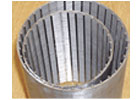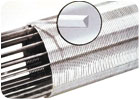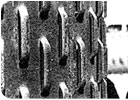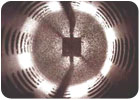
Torch-cut Slots
This is casing with vertical slots perforated by a cutting torch. Fortunately, this practice has fallen into disfavor, and is infrequently used today. The only reason for inclusion of such material in a water well is lack of an alternative. The disadvantages of torch cut slots include a low area of opening, high corrosion at the ragged torch cut edges, slag, irregular uncontrolled openings, weakness (particularly in collapsing strength) and a great tendency to clog. Even low cost is not an advantage of this material, since torch cutting with oxygen-acetylene gas is a slow process.

Milled Slots
Another vertically slotted screen is manufactured from casing by milling openings with axially oriented cutters. This product is designed for use in oil wells where fluid production is very low. Its disadvantages include clogging due to the parallel surfaces within the opening. Since slot clogging is directly related to wall thickness, thicker material encourages greater plugging. Some vertical mill-slotted casings are machined with an undercut to reduce this tendency. A second drawback is a low area of opening, although this can be overcome at higher cost by increasing the number of slots. Collapsing strength of vertically slotted casings, however, is substantially reduced when the number of openings is increased.
Field experience has proved that development generally is slower in wells screened with milled slot casings. Another aspect of vertical slots compared with horizontal openings is that sand and gravel control is less positive. A smaller aperture and/or larger gravel must be specified. The filter pack should be relatively coarse, with at least 90 percent retention, rather than the conventional 65 percent to 80 percent.
The chief positive characteristics of milled slot casings are low cost, uniform openings and availability in a fairly wide range of apertures and patterns.

Wire Wrap
One well-known well screen is manufactured by wrapping a wire around longitudinal rods. The wire is welded to the rods by resistance welding, producing a cage-shaped cylindrical configuration. This type of screen, commonly known as wire-wrap or continuous slot, usually is manufactured from type 304 stainless steel, galvanized steel and carbon steel.
The continuous slot design originated in the early part of this century to overcome the problems of ground water development from distinctive aquifers associated with the North Central United States. These aquifers were generated from rock picked up, broken and pulverized by advancing glaciers during the Ice Ages. While glacial till is not well sorted, occasionally thin layers of fine-grained, uniform sands were washed from the original deposits. Such materials are high-yielding water producing formations. Prior to the advent of rotary well construction and the gravel envelope well design, it was difficult to produce the full capacity of sand-free water from these aquifers. A well design incorporating wire-wrap screen was developed to meet these conditions, and proved successful.
The characteristics of wire-wrap screen are well suited for its original purpose. This design offers the highest surface area of opening of any screen. Consequently, with very small aperture sized (0.005 in. to 0.035 in.) necessary to control fine sands from thin aquifers without a gravel envelope, sufficient area of opening still is available to minimize frictional head losses through the screen. However, under such circumstances, stainless steel must be used because enlargement of openings results in sand pumping. The manufacturing process lends itself to close tolerances required for very fine aperture sizes, and the v-shaped slot configuration reduces clogging.
Careful consideration must be made of the use of wire-wrap screen in situations or under conditions for which it was not originally designed. It is generally more costly than other types without necessarily providing higher production, better efficiency or greater durability. Screen of this design, including most higher-cost, heavy-duty versions with bigger rods, wire or both, has lower collapsing strength than other screen types, and usually lower than the well casing it is installed with. Special care should be taken in installation.
The configuration of wire-wrap screen makes it difficult to swab, a simple and very effective method of well development, redevelopment and cleaning. This is because the internal surface of the screen is not a smooth circle, due to the cross sections of the vertical rods. Close-fitting swabs cannot be employed effectively because water bypasses through the annulus between the rods instead of surging in and out of the formation and filter pack. Development with air or high-velocity jetting is not as effective a development method, especially in gravel envelope wells. For similar reasons, cleaning and removal of encrustations is more difficult, requiring acidizing rather than removal by mechanical methods.
Wire-wrap screens also are more difficult - or impossible - to repair or restore to their original shape and structural integrity. Extra caution must be exercised using down-the-hole tools.
Finally, the high area of opening, which may be an asset under certain conditions, acts adversely in the carbon steel version. The surface area exposed to corrosion is in the order of three times that of other types of screens. This results in faster loss of weight and strength.
Since wire-wrap screen originally was developed for use in non-gravel envelope wells, its use in gravel envelope wells must take into consideration the requirements of that design for success. Avoid the practice of selective screening for reasons mentioned earlier. Do not use too small a screen aperture size. With a properly designed gravel envelope well, there is seldom any condition requiring an aperture size less than 0.040 inches. However, in this regard, it is important to note that while the v-shaped orifice of continuous slot screen reduces clogging, it does not encourage stabilization of the gravel envelope particles. The recommended aperture size is that which will retain 90 percent of the filter pack. This results in a smaller aperture size than is possible with some other screen designs.
A less expensive wire-wrap screen fabricated from round galvanized steel wire is available. This wire shape encourages plugging through the forming of particles in the narrow orifice.

Bridge Slot
Another well screen produced in the United States and overseas is referred to as “bridge slot”. This screen is manufactured on a press from flat sheets or plates. The slot opening usually is vertical, and provides two orifices longitudinally aligned to the axis. The perforated steel sheets or plates are then rolled into cylinders and the seam welded. Normally, 5-foot sections of bridge slot screen are welded together into longer lengths suitable for field installation.
Bridge slot screen usually is installed in gravel envelope wells. Its chief advantages are a reasonably high area of opening, and minimum frictional head losses at a relatively low cost. One important disadvantage is low collapsing strength due to the large number of vertically oriented slots. The manufacturing process is limited with respect to wall thickness and 0.250 inch is the maximum generally available. Since gravel control is more difficult with any vertical opening as compared to a horizontal opening, a smaller aperture size relative to the pack material should be selected.

Shutter Screen
One type of screen designed many years ago for use in gravel envelope wells has enjoyed considerable success. Shutter screen originally was manufactured by punch-formed downward-facing louver apertures into short lengths of pipe, then welding them together forming sections up to 20 feet long. A more modern method has been developed, which permits manufacture of tubes up to 50 feet in length. This process incorporates the use of an internal mandrel that perforates the shutter against external die blocks.
Shutter screen is manufactured in a variety of patterns with various surface percentage area of openings. This flexibility permits designing to meet real conditions and eliminates unnecessary cost.
One of the major advantages of shutter screen is that it has higher collapsing strength (up to 60%) than blank casing of the same wall thickness. This is due to the corrugating effect of the louver-shaped openings. Surprisingly, this strength increases as the percentage areas of opening found in commercially available shutter screen increases. Resistance to collapse does not vary according to aperture size, as in the case of wire-wrap screen.
Another important advantage of shutter screen is that tight swabbing can be employed to develop and redevelop wells without risk. This is due to high mechanical strength and a full circular cylinder interior. For the same reason, wells can be repaired and deepened more easily.
Shutter screens are available which afford much lower entrance velocities than required, minimizing head losses. The downward-facing louver aperture is suited for gravel envelope wells, and offers special advantages over other opening configurations. Use of down-the-hole cameras, model studies and years of experience confirm that the louver-shaped opening resists clogging as well as, or better than, any other type of screen. Its shape is the same for any wall thickness material. Better gravel control during installation, development and operation is characteristic of shutter screen because of the hood shaped, downward facing orifice. Tolerance of filter pack range is enhanced. Many wells have been successfully completed with greater than 80 percent of the pack capable of passing through the openings. While the recommended relationship is 35 percent to 20 percent passing, this latitude provides protection against variations in the gravel envelope due to segregation or other reasons.
Well screen is an important component of well design. It must be realized that it is not an answer to all well problems. In a gravel envelope well, it is the gravel that filters the formation material, not the screen. The screen simply retains the gravel pack. Screen selection must be based not only on the theoretical considerations, but also on a practical relationship to the design and construction of an efficient, durable installation. The best screen design cannot automatically correct in-complete gravel installation or well development. Screen can only facilitate the construction of an efficient well and help assure its satisfactory operation.
Report Abusive Comment